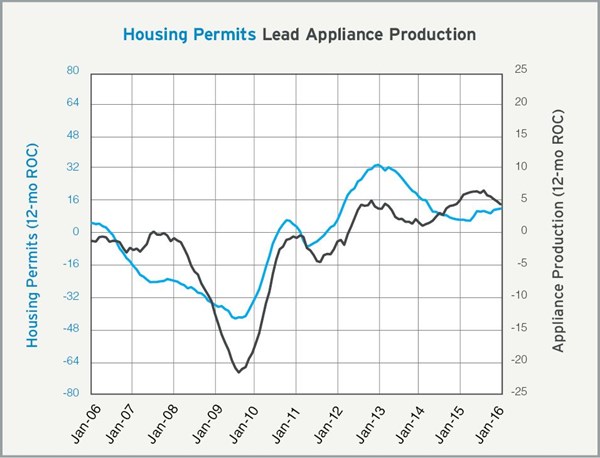Appliance and Medical
Increase in housing permits positive for appliance production; medical production could be turning up.
Increase in Housing Permits Positive for Appliance Production
The real 10-year treasury rate was 1.85 percent in January, the first time the rate was below 2 percent since November 2015 and the lowest it has been since August 2015. Since the Fed announced it was raising its overnight rate, the real 10-year treasury rate dropped each of the following two months. The change in the rate had increased for 12 months in a row, but in January it fell for the first time since the previous January.
On an annual basis, housing permits have been growing at an accelerating rate for most of the last year. The most recent turn in the change in the real 10-year treasury rate was a positive sign for housing permits, indicating that their growth rate could see further acceleration.
Housing permits are a reasonably good leading indicator of appliance production, because new homes require many new appliances. Over the last year, however, the rate of growth in appliance production was faster than one would have expected based on the rate of growth in housing permits. Therefore, appliance production may grow at a slower-than-expected rate in 2016, even with accelerating growth in housing permits. The outlook for appliance production still appears positive, however.

Medical Production Could Be Turning Up
Real medical care spending has grown at a slower rate for a couple of months, ending a streak of nearly two years of accelerating growth. Although the most recent rate of growth was still noticeably faster than at any point in the last 15 years, medical equipment production has grown at a decelerating rate for the last year. Given how strong medical care spending has been and the recent correlation between spending and production, it seems that medical device production should grow faster in 2016.
Our medical business index shows that the medical device industry contracted in February. Despite this contraction, however, the index clearly has been trending up since September. While the new orders index has been up somewhat recently, the production index has more clearly moved in a positive direction. Backlogs continued to contract, but the rate of contraction has slowed significantly since September. The employment index has spiked, growing in three of the previous four months. The export index also spiked in January and February as the growth in the dollar has moderated. Finally, supplier deliveries shortened in February, indicating that there is some slack in the supply chain.

Related Content
-
Dynamic Tool Corporation – Creating the Team to Move Moldmaking Into the Future
For 40+ years, Dynamic Tool Corp. has offered precision tooling, emphasizing education, mentoring and innovation. The company is committed to excellence, integrity, safety and customer service, as well as inspiring growth and quality in manufacturing.
-
MMT Chats: Mold Builder, Master Molder and Marble Maker? Part 1
MoldMaking Technology Editorial Director Christina Fuges introduces new MMT Editorial Advisory Board Member Mike Close, Sr. Tooling Engineer for SMC Ltd. in Devens, Massachusetts. This episode is brought to you by ISCAR with New Ideas for Machining Intelligently.
-
Predictive Manufacturing Moves Mold Builder into Advanced Medical Component Manufacturing
From a hot rod hobby, medical molds and shop performance to technology extremes, key relationships and a growth strategy, it’s obvious details matter at Eden Tool.
.jpg;maxWidth=970;quality=90)
.JPG;width=70;height=70;mode=crop)














